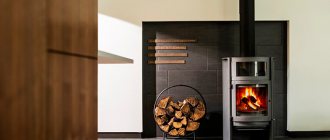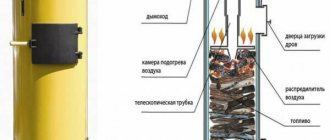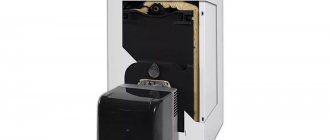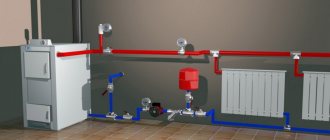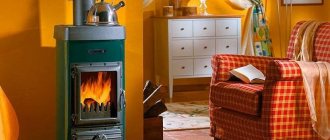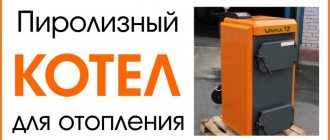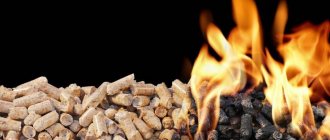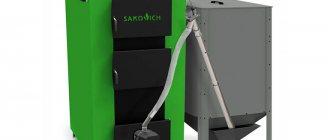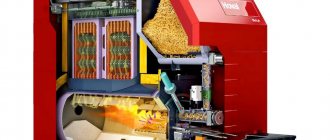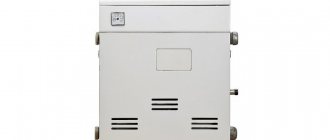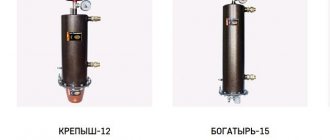To heat a large house that is not connected to a centralized gas supply system, a solid fuel boiler with a water circuit is used. The main criterion for choosing a unit is power. Models with an extended period of operation on one load of fuel are becoming increasingly popular.
A solid fuel boiler with a water circuit is used for heating.
Standard design of a circuit boiler
The classic unit includes the following components:
- Thermally insulated housing.
- An internal chamber divided by a horizontal grate into a firebox and an ash pan.
- Heat exchanger.
- Smoke exhaust pipe.
- Mechanical automation that regulates the position of the air damper.
- Devices for monitoring the temperature and pressure of the working environment.
The housing has doors for access to the firebox and ash pan. An air intake pipe with a movable damper is embedded in one of them. Some models have electric heaters built into the heat exchanger.
Design of a contour boiler.
The operating principle of mechanical automation is based on the following effects:
- changes in the geometric parameters of liquids and materials due to temperature fluctuations (bimetallic plates, etc.);
- the occurrence of EMF during uneven heating of a ring of dissimilar conductors (thermocouples).
What pipes are needed?
Instead of radiators, pipes (80-120 mm in diameter) are usually used. They are better suited for stoves (provide sufficient water volume in the system).
The main thing here is to choose the right material:
- Stainless steel;
- Metal-plastic;
- Polypropylene.
On a note! For brick stoves heated by wood, the best option is steel. It can withstand high temperatures (up to 100 Cº or more). Other materials are not designed for this load (maximum 95 Cº).
How does a boiler with a water circuit work?
The unit operates in the following order:
- The user places fuel on the grate and lights it.
- Closes the door and sets the desired temperature of the working environment using the regulator.
- The liquid is heated in the heat exchanger and rushes into the heating circuit under the influence of convection or pressure created by the circulation pump.
- Moving along a closed ring, it releases the received energy through radiators to the air in the rooms.
- When the coolant temperature exceeds the set value, the automation will close the air damper and thereby limit the flow of oxygen into the firebox.
If the model is equipped with heating elements, they will turn on after the fuel burns out. Working with minimal power, they will prevent the coolant from freezing.
Part of the automation system is a draft sensor mounted in the chimney. This is a bimetallic plate or flask with a capillary filled with liquid. If smoke removal is difficult, the sensor cools down and tightly closes the air damper. This prevents carbon monoxide from entering the room.
The boiler turns on after fuel combustion.
Advantages of the device
A solid fuel boiler with a tank has the following advantages:
- Autonomy. The unit does not depend on the operation of centralized electricity and gas supply networks.
- Easy installation. There is no need to make a project, register the unit and call specialists to connect it, as is the case with a gas boiler.
- Possibility to heat several rooms. A boiler without a heat exchanger only heats the room in which it is located.
- Safety. Unlike gas, solid fuel is not capable of poisoning the inhabitants of the house or exploding.
- Possibility of connecting an indirect heating boiler. This device provides hot water supply.
- Using cheap fuel. Prices for peat, coal and firewood are lower than for gas and electricity, and in regions rich in forests, brushwood and dead wood can be prepared for free.
Disadvantages of boilers
The weaknesses of this type of heaters are:
- Impossibility of full automation. The owner has to periodically add fuel.
- Presence of soot in combustion products. It is necessary to clean the chimney annually, otherwise plaque will flare up, which can lead to a fire.
- High thermal inertia. The boiler cannot be extinguished quickly, which increases the likelihood of the working medium boiling.
- For non-volatile models - limited functionality. It is impossible to program the unit, control it from a smartphone and connect weather-dependent automation.
- Availability of fuel storage. Storing fuel for the winter takes up a lot of space.
- Limitations on the temperature of the working medium at the inlet to the heat exchanger. It should not be below +50°C, otherwise aggressive acid condensate will form on the surface of the part.
- Dependence of efficiency on power. If the device operates in reduced heat transfer mode (the air damper is tightly closed), fuel is consumed inefficiently and a lot of soot is formed.
- Environmentally harmful exhaust. When smoke spreads across the ground, people on the street experience discomfort.
- Fire hazard. The floor and walls near the unit must be finished with non-combustible materials.
The impossibility of full automation and the presence of soot are disadvantages of boilers.
Advantages
- Economical. The services of a stove maker will cost much less than the purchase of modern devices, their maintenance and installation. The stove can be made from mortar and bricks that were left over after building the house. Repair and operation of such devices does not require large investments.
- Design variability. A modern master can build a stove of any shape and size. It can be decorated with exquisite designer decor and painted in various colors. There are designs that combine a fireplace and stove.
- High degree of maintainability. Over many years of operation, this equipment requires only minor cosmetic repairs. This is much faster, cheaper and easier than taking an expensive unit for service.
- Possibility of regulation of combustion intensity in the firebox.
- An atmosphere of comfort, which is characteristic only of Russian ancient huts with stoves.
- The intensity and speed of air heating is determined by the position of the dampers.
Types of boilers with a water circuit
For a unit of classical design (in other words, direct combustion), the fuel supply is enough for only 3-4 hours of operation. In an effort to increase this gap, engineers have created several more advanced types of boilers.
Pyrolysis
The operating principle of such heat generators is based on the ability of solid fuel to turn into combustible gas under conditions of strong heating and limited oxygen supply.
The volatile mixture enters the adjacent chamber, mixes there with air and is burned. Such boilers are also called gas generator boilers.
Their advantages:
- operating time on 1 fuel load – up to 12 hours;
- ease of control and ability to adjust – almost like gas analogues;
- environmentally friendly exhaust;
- no ash;
- Efficiency is 90-95%.
Pyrolysis boilers have an efficiency of 90-95%.
Flaws:
- high price;
- energy dependence - pyrolysis and gas combustion require a controlled air supply using fans;
- restrictions on fuel moisture – no more than 12-20%.
Top burning
These units operate on one load of fuel the longest:
- on wood – up to 30 hours;
- on coal - up to 3 days.
To achieve this effect, engineers made a number of changes to the design.
The device has the following features:
- The firebox has a large volume and the shape of a tall cylinder.
- The bookmark is set on fire from above.
- Air is supplied strictly to the combustion zone through a telescopic tube.
Top combustion units have the shape of a tall cylinder.
The flame moves down slowly. A similar phenomenon is observed when a candle burns.
Wood-burning models are non-volatile, coal models require forced air supply by a fan.
Disadvantages of boilers of this type:
- you cannot add fuel until the current fuel fill is finished;
- fuel residues often “hang” on the walls.
Pellet
These units operate on a special type of fuel.
Pellets are calibrated granules obtained by pressing plant materials:
- peat;
- sawdust;
- seed husks (for example, sunflower);
- straw;
- waste of corn and other cereal plants
Pellet fireplaces operate on a special fuel.
The small size (about 50 mm) and dense structure of the fuel allow it to be delivered to the combustion chamber using a screw feeder. It is connected to a hopper equipped with a baking powder. The duration of operation of the unit without human intervention depends on the volume of the tank.
To burn pellets you need a special pellet burner.
Advantages of boilers of this type:
- Unlimited period of operation without human intervention. You can make a bunker that can hold a supply of pellets for the entire heating season.
- Full automation. The controller regulates the feed rate of granules based on the readings of the temperature sensor.
- Zero thermal inertia. After stopping the feeder, the flame dies out within a few seconds.
Flaws:
- energy dependence;
- the need for special fuel that cannot be made at home.
Principle of operation
Boiler units are quite simple in their operating principle, based on the basic laws of physics.
The principle itself includes successive points:
- Loading a suitable type of fuel;
- Ignition of fuel using a burner or other fire source;
- Combustion of fuel, during which heat is released and thermal energy is transferred to the coolant for the heating circuit or hot water supply;
- Exhaust of flue gases into the atmosphere through a chimney by natural or forced circulation;
- Natural or forced circulation of heated coolant through the heating system.
How to choose a boiler with a water circuit
When buying a heater, pay attention to the maximum permissible pressure of the working medium indicated in the characteristics. For most models, the heat exchanger is designed for 3 atm, for some - 1.5 or 4. Excessive pressure is created by a water column (in multi-story buildings) and a circulation pump.
A number of other parameters need to be taken into account.
Fuel type
Depending on the fuel used, boilers are divided into 3 types:
- wood;
- coal;
- universal.
Boilers vary in fuel type and can run on wood or coal.
The first ones are designed for low temperatures. If such a device is heated with anthracite, the latter will quickly burn out.
Universal units can be converted to gas. Installing the burner takes a few minutes. This option is suitable for those who expect gasification of the settlement in the near future.
Boiler power
The capabilities of the device should be enough to cover heat loss during the coldest period of winter.
This value depends on many factors:
- material and thickness of the building envelope;
- glazing areas;
- lowest temperature in a given climate zone.
A special calculation is required, which is entrusted to a heating engineer. A simplified version can be done independently. It is believed that for a house with thermal resistance of enclosing structures that meets SNiP standards for a given region, the required boiler power is 1 kW for every 10 sq. m of heated area. Residents of northern latitudes add 20% to the resulting value.
The boiler power depends on the material of the house and the area.
Solid fuel devices develop rated efficiency only at rated heat transfer. It is recommended to install 2 units: one designed for average winter temperatures, the other low-power. In extreme cold, the devices are used together, in the off-season - only the second one.
Ash pit design
The criterion for this element is ease of cleaning. The ash pan door should provide free access to the far corners of the chamber.
The following boiler models are most convenient:
- with drawer;
- with automatic ash removal using a screw or piston mechanism.
The second type has a disadvantage - energy dependence. It is not suitable for areas with frequent power outages.
Thrust inside the chamber
Air supply to the firebox and smoke removal are carried out in different ways.
Based on this feature, boilers are divided into 2 types:
- With natural cravings. Gas exchange in the chamber occurs spontaneously due to convection - the tendency of hot air to move upward.
- With forced or additional. Air is sucked in from the street by a fan.
Traction inside the chamber is carried out in different ways.
The second type has many advantages:
- Safety - after loading the fuel, the chamber is tightly closed, which prevents carbon monoxide and sparks from entering the room.
- No special requirements for ventilation.
- Possibility of horizontal installation of the chimney.
- Long-term operation on 1 fuel load: when the set temperature is reached, the fan stops operating and the boiler temporarily “turns off”.
There is only one drawback, but a significant one - energy dependence. In the absence of power supply, such a device is ineffective.
Efficiency
This indicator depends on the type of equipment:
- 60-75% – for classic models;
- 85-93% – for solid fuel top combustion boilers – 85-93%;
- 91-95% – for pyrolysis;
- 91-95% – for pellet ones.
There are 2 methods of calculating efficiency: by direct and reverse balance. The methods give different results. When comparing the efficiency of several models, it is necessary to clarify the method for calculating them.
Load Type
Fuel is placed in the firebox in 2 ways:
- manually;
- automatically using a screw or piston feeder.
Fuel can be supplied automatically using a feeder.
Boilers of the second type work for a long time without human intervention, but have disadvantages:
- energy dependence;
- restrictions on types of fuel (only fine-grained coal is suitable: pea coal, sawdust, pellets, etc.).
Heat exchanger housing material
Boilers are equipped with 2 types of tanks:
- cast iron;
- welded steel.
The first have the following advantages:
- strength;
- corrosion resistance.
As a result, they are reliable and durable.
Flaws:
- high price;
- heavy weight;
- susceptibility to sudden temperature changes (explained by fragility);
- impossibility of repair: the damaged heat exchanger is replaced entirely.
The material of the heat exchanger housing must be durable.
Steel counterparts, on the contrary, are cheap and lightweight. You can cut off the damaged section and weld a new one. But due to their low strength and susceptibility to corrosion, they leak more often.
Water jacket location
The design in which the heat exchanger is located above the firebox is ineffective. Boilers with a water jacket, which additionally covers the combustion chamber on 3 sides, are designed more rationally. Some models have smoke exhaust channels (fire tube heat exchanger) passed through its upper part.
Weight and dimensions
The dimensions of the unit must ensure compliance with fire safety standards and ease of maintenance. According to them, the minimum distance from the surface of a solid fuel boiler to the wall is 0.8 m, from the side of the firebox door - 2 m.
The weight of the device cannot exceed the strength limit of the supporting base.
Low-power models are installed on the floor, including a reinforced concrete floor above the basement. Boilers weighing over 300 kg are on a separate foundation.
Budget
Domestic heaters are the cheapest.
Their other advantages:
- low cost of repairs;
- fast delivery of spare parts;
- immunity of electronics to voltage surges inherent in electrical networks in the post-Soviet space.
Russian boilers are not inferior in quality to their foreign counterparts. Their only weak point is less functional electronics. But many models use imported controllers and sensors, which eliminates this drawback.
Russian boilers are not inferior to foreign ones.
When choosing a boiler based on the type of fuel, you also need to take into account financial capabilities.
Preferences depend on what resources a given region has.
In most cases, the most accessible fuel is firewood. On average, pellets cost 1.5-2 times more, coal – 3 times.
Tips for choosing a stove
Recommendation number one: to heat the coolant in the water heating network, use a solid fuel boiler. If necessary, buy a long-burning model with a loading chamber volume of more than 100 liters. Modern TT boilers direct 75-80% of combustion energy to heat water and hardly raise the ambient temperature.
If, for various reasons, you want to install a stove with a heat exchanger, listen to the following tips:
- A cast iron or steel potbelly stove is well suited for a small cottage with an area of 40-80 m². The heater is enough for convection heating of the central room; place radiators in adjacent rooms.
- A fireplace insert or iron stove, equipped with panoramic glass, will be a successful decoration in the living room. One condition: use the product as an additional heat source, and place the main load on a gas or wood heat generator. Then you will be able to maintain cleanliness and order around the potbelly stove.
An example of a diagram for connecting a fireplace, a gas double-circuit boiler and radiator heating - When building a house, definitely install a brick stove. This is the best option compared to iron heaters.
- Theoretically, the power of the fireplace insert is enough to heat an area of 100-120 m². Practice shows: without the help of a second heat generator, it will have to be loaded with firewood at intervals of 3-4 hours. Therefore, expect a smaller heating area.
Important point. All wood-burning heaters equipped with a water circuit have one feature in common: due to intensive heat extraction, the surfaces of the register and the walls of the chimney are abundantly covered with soot. The only way out is to heat the stove at maximum so that the soot deposits burn out from the high temperature. Maintaining this mode is not always convenient.
How to select a design and calculate the heat exchanger area in a brick version of the furnace:
- If the register is located inside the firebox, 1 m² of its area can transfer up to 10 kW of heat to water. Example: you need to heat 80 square meters of space - you will need about 8 kW of energy and a heat exchange surface of 0.8 m².
- The coil in the chimney duct is not as effective. Expect a heat output of 400-500 W per 1 m² of register.
- For ease of cleaning, it is better to make the boiler flat - in the form of a tank with inlet pipes. Ribbed structures made from round pipelines are more difficult to clean. For installation inside the flue, weld the register from profile pipes.
- The heat exchanger material is low-carbon steel St10...St20 with a thickness of 4-5 mm. It is allowed to use heat-resistant and stainless steel 2-4 mm, but it must be cooked in an inert gas environment - argon.
- It is strictly not recommended to use ready-made cast iron batteries. Reasons: the metal cracks from temperature shock, and the seal between the sections will burn out over time and leak.
Advice. Do not overestimate the heat exchange area of the circuit “in reserve”. The furnace body will receive much less heat, and the water in the register may overheat and boil. Do not place corrugated stainless steel pipes in the chimney - its actual area and workmanship are difficult to determine.
Home craftsmen are constantly putting forward various ideas for improving heaters. The option with steel flat batteries used as furnace water heaters is worthy of attention. Watch the video for an overview of the wizard:
Operation of boilers with a water circuit
The use of a solid fuel heater is accompanied by the risk of accidents with serious consequences:
- fire;
- carbon monoxide poisoning of residents.
To avoid such events, you must strictly follow the manufacturer's instructions.
Installation details
The solid fuel device is located in a non-residential premises with the following parameters:
- with 1 entrance from 0.8 m wide without automatic locking devices;
- volume 15 cu. m + 0.2 cu. m for each kW of power;
- area from 7 sq. m;
- with a ceiling height of 2.5 m or more;
- with gas-tight walls (partitions) with a fire resistance limit of 0.75 hours;
- with sufficient ventilation (performance is determined by calculation);
- no attic or living rooms above.
The choice of base depends on the mass (kg):
- up to 200 – cement-sand screed;
- 200-300 – reinforced concrete;
- over 300 – separate foundation.
The boiler is located in a non-residential area.
The distance from the installation to the walls is 1 m. If they are covered with fireproof material, for example, vermiculite plaster with a layer of 25 mm, the distance is reduced to 800 mm.
The floor with wooden or other combustible cladding within a radius of 1.2 m from the center of the combustion door is protected by a 1.2 mm thick steel flooring on a basalt cardboard backing.
Combination with heating system
Solid fuel units are recommended to be connected to open circuits. This is due to the high probability of the coolant boiling. If a closed system is used, a safety group of the following devices is placed at the boiler outlet no further than 0.5 m from it:
- safety valve;
- pressure gauge;
- air vent.
The 1.5 m long sections of the circuit adjacent to the unit are made of steel or copper pipes; the rest can be made of polypropylene or metal-plastic.
Solid fuel boilers are afraid of an environment with a temperature below +50°C entering the heat exchanger. This leads to the formation of aggressive acid condensate on its walls. In order to prevent such phenomena, the supply and “return” near the boiler are connected by a jumper on which an automatic 3-way valve is installed. It is controlled by an electronic or mechanical temperature sensor.
If the temperature drops below the permissible level, the valve opens slightly and mixes hot coolant from the supply into the “return”.
About the disadvantages and advantages of brick
A brick oven is a complex, heavy structure that requires a separate foundation and major construction work in the house. It is much more difficult to install a water circuit in a brick oven than in a steel oven, see below. But at the same time:
- A brick stove maintains optimal humidity in the house: it absorbs excess water vapor from the cool air and releases it when heated during combustion.
- It also sets the optimal temperature field for health in the room: from the walls to the center it gets warmer.
- Reduces heat loss in the house: flows of air heated by the stove create a downward thermal curtain in front of the windows, which is much more effective than the upward one from the registers (heating radiators) under the windows.
- Evens out the microclimate in the house: in summer it absorbs some of the excess heat and transfers it through the foundation to the ground. In winter, it warms up the house a little in the same way.
- For the reason in the previous point stabilizes the settlement of the building, making it more reliable, stable and durable.
Note: in the history of construction, there are many cases where strong houses, converted from stove to central heating, began to collapse after dismantling the stoves.
Good manufacturing companies
Many companies produce boilers. It is better to give preference to brands that have been on the market for a long time and have proven themselves well. They use high-quality, thick steel that does not burn out for a long time, and reliable automation systems.
Russian
The best domestic manufacturers of heat generators are:
- "Teplodar".
- "Zota."
- LLC "Obschemash"
- "Prometheus".
- "Siberia".
- "Hearth."
- Lemax.
Boilers are produced by many companies.
Foreign
Imported equipment of the following brands is highly rated:
- Buderus.
- Viessman.
- Ferroli.
- Stropuva.
- Sime solida.
Heat exchanger
Various materials are used for stoves with water heating boilers:
- Low-carbon steel, in the form of a coil of pipes with a diameter of 4 to 5 cm (or an assembly of sheet steel, up to 0.5 cm thick);
- Cast iron, use old batteries made from it, preferably compact in size (to fit in the firebox);
- Copper (the most expensive option).
A tubular steel device is more efficient in operation, but more difficult to manufacture. Disadvantage of cast iron products: they are difficult to clean from accumulating soot (ribs get in the way). Copper cameras are rarely used, they are difficult for the owner to assemble, and expensive to purchase.
By the way. The heat exchanger significantly reduces the usable area of the firebox. There must be a gap between them - up to 15 mm (for products made of sheet steel - up to 10 mm).
Customer reviews about solid fuel boilers with a water circuit
Vasily, 44 years old, Magadan:
“I use a pellet heat generator with a tank to connect to the heating system. In terms of convenience, it is comparable to a gas one: I fill the bunker with fuel once every 3 days, the power is adjusted automatically within a wide range. Pellets are more expensive than firewood, but you don’t have to work as a fireman. We are waiting for the gas line to be connected - then I will install the burner.”
Alexander, 52 years old, Arkhangelsk region:
“I have been using TT boilers for a long time, since I live in a non-gas supply village. At first there was a classic unit. It is inconvenient because you have to add fuel every 3 hours. I replaced it with a pyrolysis one: this smokes less, works longer, and is easy to adjust. I stack the firewood in the boiler room to dry it. You can’t put raw ones in such a unit - it will coke.”
What is the essence of the problem
The heating boiler was invented precisely to replace the stove as a heat-generating device in heating systems (CO). The boiler is a continuous operation device that ideally requires the user only to periodically reload fuel and seasonal maintenance. Its fundamental difference from a furnace is its automation, which maintains the combustion mode optimal for a given operating mode. Automation is not necessarily electronic; it can be a non-volatile combination of bimetallic plates, springs and levers.
The oven is a manually operated intermittent device, which is why it is cheaper. It's not about the automatic transmission. It's about the very fundamentals of the approach to design and production. Specifically, in the methods of organizing complete combustion of fuel. If we continue the shipbuilding analogy, then the boiler is no longer a displacement vessel, but a glider. Which can also float like a steamship, but will show its full qualities only when it reaches the redans. However, planing requires relatively calm water; a properly constructed and adjusted CO, figuratively speaking, is what it is for a boiler. The furnace (continuing the same analogy) under the control of an experienced crew can go at full speed in significant seas. Thanks to this reserve of operational endurance, it is possible to adapt the stove for water heating. Full speed (the same analogy) will be quieter than that of a glider (maximum thermal efficiency 60-65% versus 80-95%), but, “going at economic speed in calm water,” the specific fuel consumption for heating a unit of cubic capacity of a house can do not exceed that of the boiler.
Note: the thermal efficiency of heat-generating devices is a complete analogue of the efficiency for internal combustion engines.
How to choose and what to pay attention to?
What qualities must a heating equipment have to become a reliable source of heat?:
- Power . Varies with the size of the firebox and the dimensions of the stove. On average, a room of 10 m² requires 1 kW of power.
- Dimensions . Must fit into the installation room.
- Coolant volume . It consists of the volume of pipes and radiators, depending on the total length of the system and the number of batteries. Another 10% is added to the resulting value.
- Chimney cross section . The indicator is important for selecting suitable structural elements.
- Additional options . Cooking and heating food, easy glass cleaning, non-heating handles and other easy-to-use little things.
Device Features
A fireplace stove with a built-in water circuit is a steel chamber with varying wall thicknesses . In a closed system the indicator will be 6 millimeters, in an open system - 4 millimeters.
Heat exchanger tubes are mounted between the walls to circulate the coolant liquid. To be able to control the temperature in the oven, temperature sensors are installed.
The air flow into the combustion chamber is usually adjusted manually.
NOTE!
Exterior design can be made using various materials in order to fully comply with the overall style of the interior.
In summer, such equipment can only be used for water heating.
